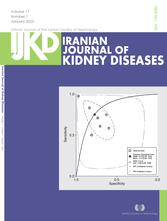Measured GFR in Donor Selection, to Do or Not to Do? That is the Question
Abstract
Introduction. The accurate assessment of the pre-donation glomerular filtration rate (GFR) is a crucial step in donor selection. We conducted a prospective cross-sectional study to identify the best equation to estimate GFR and the necessity of a radio-nuclear scan in GFR evaluation. Methods. In this study, 154 potential donors were enrolled, and GFR equations (the MDRD study, the CKD-EPI study, and the full age spectrum [FAS]), and creatinine clearance were compared with measured GFR (mGFR) by the radio-nuclear method. Results. The study results indicate that Potential donors had an mGFR of 95.56 ± 15.57 mL/min per 1.73 m2. Though body surface area (BSA) adjusted full age spectrum (FAS) and CKD-EPI equations were most correlated with mGFR, the correlation coefficients were weak (ICC: 0.3 and 0.32, respectively). Misclassification at the cut-off of 80 cc/min/ 1.73 m2 was about 42% for both equations. Besides, 16.8% of donors with eGFR more than 80 cc/min/ 1.73 m2 had a difference in split renal function, and 57.1% of participants had a > 2% probability of having an mGFR < 90 mL/min per 1.73 m2. Conclusion. If the nuclear scan is easily available, we suggest measuring GFR by 99mTc -DTPA scan as the preferred method. Otherwise, our data suggest utilizing mGFR in patients with high body mass index, size asymmetry in CT-scan, eGFR less than 90 mL/min per 1.73 m2 with FAS and/or CKD-EPI equation as these factors deviated the estimated GFR, and also in those with inaccurate creatinine clearance measurements or with posttest probability of having mGFR less than 90 mL/min per 1.73 m2 more than 2%.
DOI: 10.52547/ijkd.7271
Downloads
Download data is not yet available.
Downloads
Published
2023-02-01
Issue
Section
ORIGINAL | Transplantation
How to Cite
Measured GFR in Donor Selection, to Do or Not to Do? That is the Question. (2023). Iranian Journal of Kidney Diseases, 17(1), 54-60. https://ijkd.org/index.php/ijkd/article/view/7271


